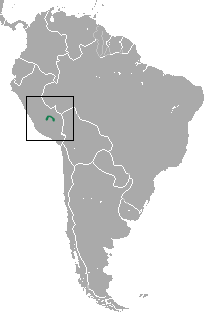
Anderson's four-eyed opossum is an opossum species from South America. It is found in Brazil, Colombia, Ecuador, Peru and Venezuela. Its dorsal fur is dark, with a black stripe, about 3–4 cm wide, going vertically down the midline of its back. Its dorsal fur is short, about 10 mm long. Its ventral fur is dark gray, but still distinctly lighter than the sides and dorsum. Its tail is furred for the first (approximately) 18% of its length, going from the base to the tip. Its species name "andersoni" was chosen to honor American scientific collector Malcolm Playfair Anderson.
Anderson's white-bellied rat is a species of rodent in the family Muridae. It is endemic to China and known from Yunnan, Sichuan, and Shaanxi provinces. Its range might extend to northern Guizhou. It inhabits montane forest at elevations of 2,000–3,000 m (6,600–9,800 ft) above sea level. Its species name "andersoni" was chosen to honor American scientific collector Malcolm Playfair Anderson.

The heavy-browed mouse opossum, or Anderson's mouse opossum, is a species of opossum in the family Didelphidae. It is endemic to a restricted range in southern Peru. This opossum inhabits forests; it is nocturnal and probably arboreal.

The Anderson's shrew mole is a species of mammal in the family Talpidae. It is endemic to China. Its species name "andersoni" was chosen to honor American scientific collector Malcolm Playfair Anderson.
The brown-spotted rock cod or cat-face rock cod is a species of fish in the family Serranidae found off the coasts of Mozambique and South Africa. Its natural habitats are shallow seas, coral reefs, and estuarine waters.

Dermacentor andersoni, commonly known as the Rocky Mountain wood tick, is a hard tick, or member of the Ixodidae family, with three life stages including larvae, nymph and finally adult, or, more entomologically, imago. This tick is generally located in the northwest United States and southwest Canada along the Rocky Mountains. This tick is generally a vector for Colorado tick fever but can also be a vector for Rocky Mountain spotted fever and Tularemia. During the larvae and nymph stages, the tick will not feed on humans, but during the adult stage, it will. However, the larvae and nymph forms will feed on small mammals, including dogs and other wildlife. Prevention of infections associated with these ticks is based on control of exposure to the vector, including: wearing proper clothing when in woods/wet areas, and checking oneself thoroughly after returning home. Adult female ticks can feed for 5 to 15 days, thus it is very important to remove a tick if present. Follow general tick removal tips.
Cerradomys scotti, also known as Lindbergh's oryzomys, is a rodent species from South America in the genus Cerradomys. It is terrestrial and is found in the cerrado (savanna) ecozone of south central Brazil, Bolivia and Paraguay. The species is common and appears to tolerate a degree of agricultural habitat modification.
Nyctonympha is a genus of longhorn beetles of the subfamily Lamiinae, containing the following species:
Nyctonympha genieri is a species of beetle in the family Cerambycidae. It was described by Martins and Galileo in 1992. It is known from Ecuador.
Nyctonympha howdenarum is a species of beetle in the family Cerambycidae. It was described by Martins and Galileo in 1992. It is known from Colombia.
Nyctonympha taeniata is a species of beetle in the family Cerambycidae. It was described by Martins and Galileo in 1992. It is known from Panama and Trinidad and Tobago.
Nyctonympha affinis is a species of beetle in the family Cerambycidae. It was described by Martins and Galileo in 2008.
Nyctonympha annulata is a species of beetle in the family Cerambycidae. It was described by Per Olof Christopher Aurivillius in 1900. It is known from Panama and Venezuela.
Nyctonympha boyacana is a species of beetle in the family Cerambycidae. It was described by Galileo and Martins in 2008. It is known from Colombia.
Nyctonympha carcharias is a species of beetle in the family Cerambycidae. It was described by Lameere in 1893, originally under the genus Hebestola. It is known from Venezuela.
Nyctonympha carioca is a species of beetle in the family Cerambycidae. It was described by Galileo and Martins in 2001. It is known from Brazil.
Nyctonympha costipennis is a species of beetle in the family Cerambycidae. It was described by Lameere in 1893. It is known from Venezuela.
Nyctonympha cribrata is a species of beetle in the family Cerambycidae. It was described by Thomson in 1868. It is known from Colombia.
Nyctonympha flavipes is a species of beetle in the family Cerambycidae. It was described by Per Olof Christopher Aurivillius in 1920. It is known from Bolivia, Ecuador, Brazil, and Peru.
Nyctonympha punctata is a species of beetle in the family Cerambycidae. It was described by Martins and Galileo in 1989. It is known from Argentina.






